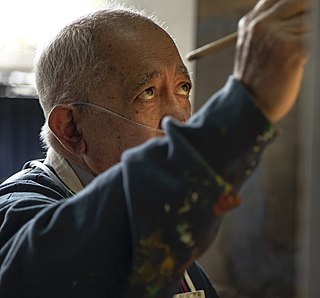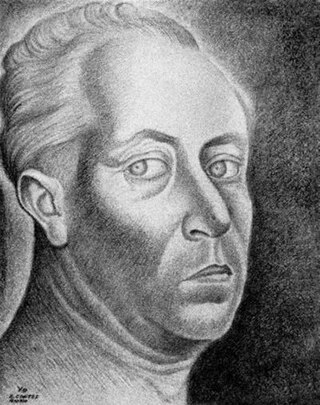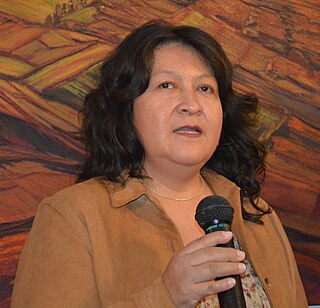
Arturo Estrada Hernández is a Mexican painter, one of a group of Frida Kahlo’s students called “Los Fridos.” Estrada is mostly known for his mural work, which remains faithful to the figurative style and ideology of Mexican muralism. He has created murals in various parts of Mexico in both public and private places, including a 1988 mural found in the Centro Médico metro station in Mexico City. He has also taught classes at the Escuela Nacional de Pintura, Escultura y Grabado "La Esmeralda", where he was a student, since 1948 and continues to give classes there and other venues. He lives in his birthplace: Panindicuaro, Michoacán.

Gilberto Aceves Navarro was a Mexican painter and sculptor and a professor at the Escuela Nacional de Artes Plásticas and Academy of San Carlos. There have been more than two hundred individual exhibits of his work, with his murals found in Mexico, Japan and the United States. He received numerous awards for his work including grants as a Creador Artístico of the Sistema Nacional de Creadores de Arte, Premio Nacional de Ciencias y Artes and Bellas Artes Medal from the Instituto Nacional de Bellas Artes.
Abelardo Ávila Villarreal was a Mexican engraver of the Costumbrista work, notably with Sociedad Mexicana de Grabadores. He also one mural along with Pedro Rendón at the Abelardo L. Rodríguez market in Mexico City. Disciple of Francisco Díaz de León and Carlos Alvarado Lang.
Azteca de Gyves is a Mexican artist from Juchitán de Zaragoza in the state of Oaxaca. She is of Zapotec heritage and one of only two prominent female artists in her city. She has been a member of the Salón de la Plástica Mexicana since 1998 and has exhibited her work individually and collectively in Mexico, Brazil, the United States, Japan and other countries.

Deyanira África González Melo is a Mexican sculptor who generally works in ceramics, depicting elements of the human form, especially the torso, generally with mutilations and other disturbing elements to dispute the otherwise traditional and sensual depictions of the human body. She has exhibited her work since studying at the Escuela Nacional de Artes Plásticas (ENAP) in Mexico as well as in Europe and the Caribbean. Her work has received recognition in Mexico and abroad, and is a member of the Salón de la Plástica Mexicana.
Rosa Castillo Santiago was a Mexican sculptor, and founding member of the Salón de la Plástica Mexicana.
Fidencio Castillo Santiago was a Mexican artist, educator, and a founding member of the Salón de la Plástica Mexicana.

Erasto Cortés Juárez was a Mexican artist and a founding member of the Salón de la Plástica Mexicana.

Herlinda Sánchez Laurel was a Mexican artist and art professor at the Universidad Nacional Autónoma de México. Her career has been recognized by membership in the Salón de la Plástica Mexicana, and awards from the state of Baja California, the Palacio de Bellas Artes and the International Coordination of Women in Art among others.
Beatriz Zamora is a Mexican artist who is best known for her monochrome works in black. Although she has struggled commercially, her work has been recognized at various points in her career such as with membership in the Legion of Honor of the Académie des Beaux-Arts in France and the Sistema Nacional de Creadores de Arte in Mexico.

Sarah Jimenez Vernis was a Mexican artist known for her political graphic work in the mid 20th century, especially with the Taller de Gráfica Popular, earning her membership in the Salón de la Plástica Mexicana. After her time with the Taller, her career shifted to teaching, and her work became mostly forgotten. However, there have been efforts to revive interest in it.

Diana Salazar is a Mexican artist, whose career has been split between production and teaching since 1995. She has worked primarily in painting, but also in photography, printing and ceramics. Her work has been recognized with membership into Mexico's Sistema Nacional de Creadores de Arte as well as grants and awards.
Rosa María Alfonseca Arredondo is a Mexican graphic artist whose work has been recognized with membership in Mexico's Salón de la Plástica Mexicana.

Chappie Angulo was an American-Mexican painter and illustrator whose work has been recognized with membership in Mexico’s Salón de la Plástica Mexicana.

Angelica Carrasco is a Mexican graphic artist who is a pioneer of large scale printmaking in the country. Her work often is related to violence and classified as “abstract neo-expressionism.” Much of her career has been dedicated to teaching and the promotion of the arts, especially the graphic arts and has been recognized with membership in the Salón de la Plástica Mexicana and the Sistema Nacional de Creadores de Arte.
Olivia Guzmán is a Mexican sculptor whose work has been recognised with membership in Mexico's Salón de la Plástica Mexicana.
Mary Martín was a Spanish-Mexican artist whose work has been recognized with membership in the Salón de la Plástica Mexicana.
Patricia Mejía Contreras was a Mexican sculptor and graphic artist whose work was recognized with membership in the Salón de la Plástica Mexicana.
Flor Minor is a Mexican sculptor and graphic artist, known for bronze sculptures and graphic work that generally depict the male form. Her works often are based on the concept of balance or lack thereof. Minor has had individual exhibitions in notable venues in Mexico and abroad, and her work can be found in a number of public and private collections. She has been recognized in Mexico with membership in the Salón de la Plástica Mexicana.
Yolanda Quijano is a Mexican painter and sculptor whose work has been recognized with membership in the Salón de la Plástica Mexicana.









